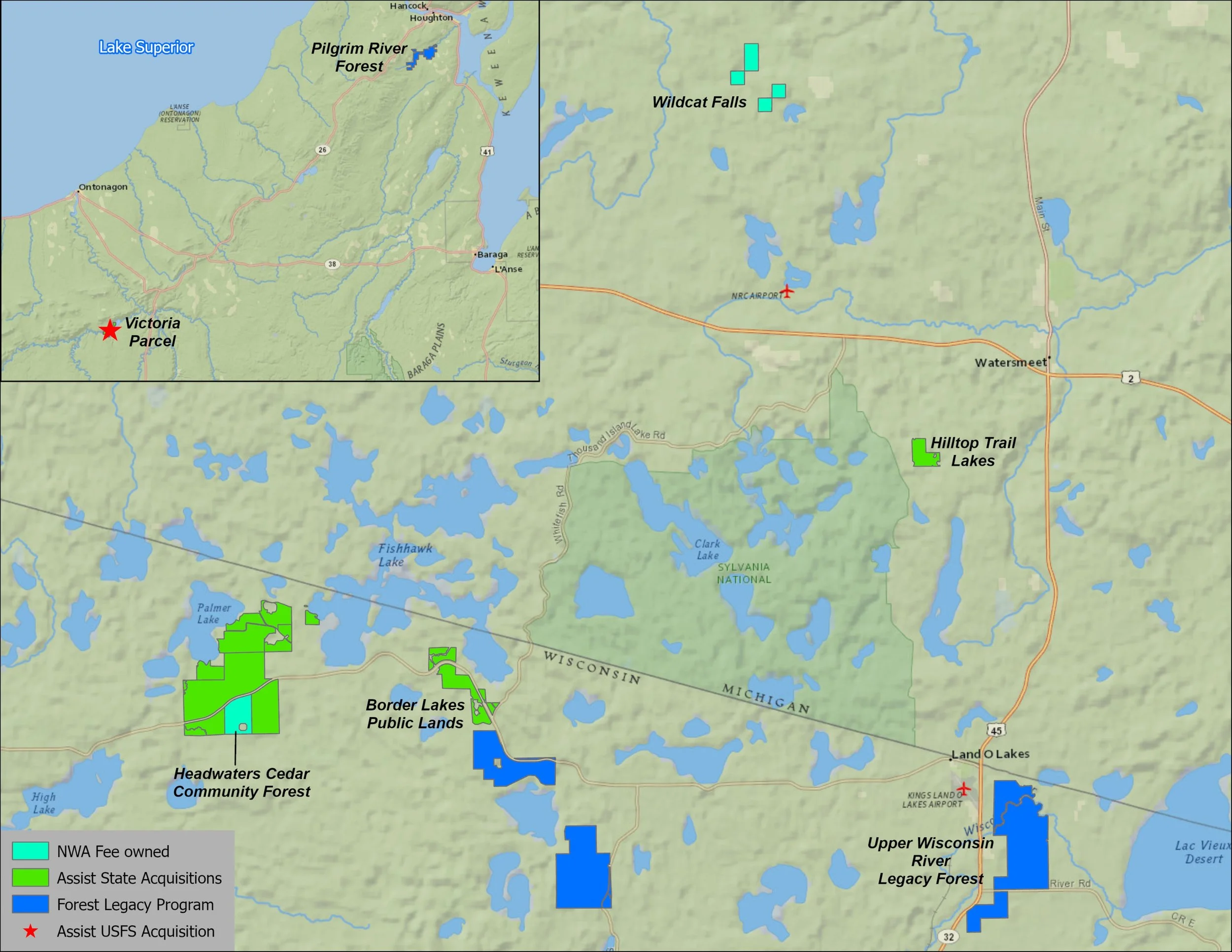NWA Land Conservation Initiative
Current focus: Border Lakes region
“We abuse land because we see it as a commodity belonging to us. When we see land as a community to which we belong, we begin to use it with love and respect.” Aldo Leopold
The Northwood Alliance has long advocated for local communities through education, strengthening environmental networking, and assisting in local action. In 2007, the Land Conservation Initiative was approved by the NWA board, to build toward the goal of facilitating land conservation through acquisition. The first project of this initiative, the Wildcat Falls Community Forest, was completed in 2021. We look forward to future projects.
Motivations of the Land Conservation Initiative
One of the top conservation concerns in Northern Wisconsin and the Upper Peninsula of Michigan is the parcelization of forestlands and the subsequent development, largely consisting of second homes. This trend not only threatens the ecological communities of the area, but stands to change the way of life for residents and visitors alike. A glimmer of hope lies in the activity of local land trusts. These organizations work with land owners on land protection agreements, called conservation easements, to develop a land use strategy with conservation as a primary goal. When executing a conservation easement the landowner will usually donate the development rights to a land trust, receiving a tax deduction and assurance that development or fragmentation will be perpetually restricted on their lands.
Some landowners who consider donating a portion of their property value to a land trust are not prepared for the costs they may incur, and in some cases the costs may offset the tax deduction value. These expenses may add up from the appraisal work, the baseline legal documentation, the monitoring fund, and so on. To address this, NWA has designed a program in order to network support from Northwoods conservation enthusiasts to help offset the expenses landowners may face when embarking on a conservation effort. As a community education and conservation action advocate, NWA understands the benefits to a community when a parcel with conservation value is protected. Adjoining landowners may enjoy increased property values while sharing the long term tranquility and aesthetic values from their neighbors’ conservation choice. It is only fitting that benefiting members of the community support these efforts. Additionally, NWA recognizes the responsibilities we share in environmental protection, and the goals of the Land Conservation Initiative include habitat preservation, protection of ground and surface water, and biodiversity maintenance.
The Northwood Alliance Land Conservation Initiative is not a land trust, but acts as a supporting partner to land trusts involved in our project locales. We value the relationship we have with Keweenaw Land Trust and the Northwoods Land Trust and with the members of the sustainable forestry community such as Partners in Forestry Cooperative.
Please contact us for more information or with any questions. On request we will share specific locations and projects with potential donors and partners, and we welcome your suggestions.
NWA will work to assist other conservation groups and land trusts in areas that are well covered, and will work directly on land conservation in areas not well served by other groups. We believe in land conservation for the social, environmental, economic and intrinsic benefits to the public.
Current focus region: the Border Lakes
The Border Lakes region, in northern Vilas County WI, is a critical conservation priority under our Land Conservation Initiative. This ecologically significant region is located along and across the border of northern Wisconsin and the Upper Peninsula of Michigan. Numerous recreational and resource-based learning opportunities exist in this important and unique ecological region. The Border Lakes region is heavily forested, and over 100 glacial-origin lakes are connected by a network of pristine, freshwater streams and wetlands which support abundant and diverse wildlife. On the Wisconsin side, the Northern Highland State Forest was expanded north in 2005 to provide for potential acquisition in this region. While some successes are noteworthy in this area (see the Border Lakes Tract), the current rate of forest fragmentation is degrading the region at unprecedented levels.
We are especially concerned about protection of the Lake Superior Watershed, and we are currently pursing the Headwaters Cedar Community Forest project and supported the Forest Legacy application process for the now-awarded Presque Isle River project, as well as other past projects. Our previous efforts in this area have gained us contacts and trust; with the current threats to habitat in this region we must step up our efforts to invoke numerous conservation strategies with receptive landowners, in search of permanent solutions.
Partners in this endeavor are widespread, as is seen by the support for the Headwaters Cedar project. We value these partnerships, including Lac du Flambeau Band of Lake Superior Chippewa, Upper Peninsula Environmental Coalition, Northwoods Land Trust, Wisconsin Green Fire, Keweenaw Land Trust, Land O Lakes Fish and Game Club, Town of Land O Lakes, Wisconsin DNR, The Nature Conservancy of Wisconsin, Sustainable Resource Institute and Partners in Forestry Cooperative, with support from the University of Wisconsin Center for Cooperatives.
Together we can make a positive impact in conserving habitat in this nationally significant wildlife area.
Characteristics of the Border Lakes region include:
Watershed divide between Lakes Superior, Manitowish River, Wisconsin River, with Lake Michigan lying just east
Connectivity from NHAL to Ottawa National Forest
Wisconsin Wildlife Action Plan states Border Lakes is the best opportunity to conservation of old growth and closed canopy forest
Heart of Border Lakes is along the border from Lac View Desert (Wisconsin River) on east to Presque Isle River at west, but region stretches much further
Conservation strategies may include acquisition by WDNR, BCPL, Ottawa National Forest or non-profits such as NWA, Nature Conservancy and land trusts-
Strategies may also center around easements such as Forest Legacy or donated to NWLT or KLT
Benefits of Border Lakes conservation impacts the Great Lakes and the Mississippi River watersheds



